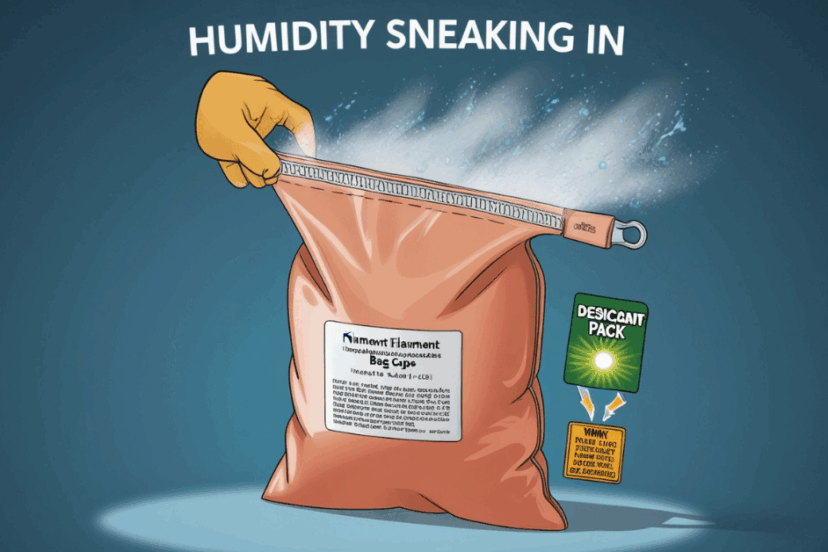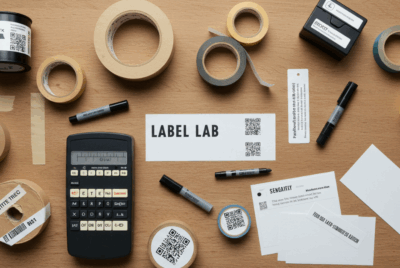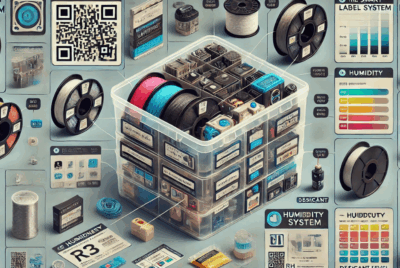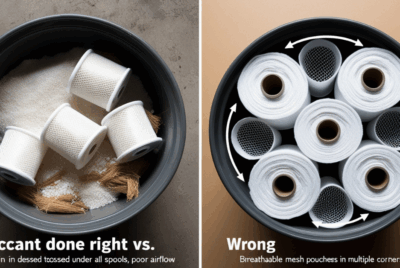How Do I Know If My Vacuum-Sealed Filament Is Still Dry?
1. Just Because It’s Sealed Doesn’t Mean It’s Safe
Vacuum sealing your filament is a great step toward moisture protection…
…but it’s not a forever fix.
So how do you know if your vacuum-sealed filament is still dry?
Let’s walk through how to test it—without wasting time or ruining a print.
2. Why Filament Still Absorbs Moisture in Vacuum Bags
Even in a sealed bag, filament isn’t 100% safe forever. Here’s why:
- Tiny leaks from aging seals
- Moisture left inside the bag before sealing
- Desiccant packs losing effectiveness
- Humidity sneaking in during quick openings
A bag may look airtight, but invisible leaks can still ruin your spool over time.
3. Signs Your Vacuum-Sealed Filament Might Be Wet
Watch for these visual cues:
- Silica gel turned color (e.g., blue to pink, orange to green)
- Humidity card showing RH > 30%
- Condensation on the inside of the bag
- Bag puffing slightly—may indicate air leak
- Spool looks dull or dusty (signs of moisture exposure)
If your storage bag shows any of these… time to act.
4. Tools to Check Filament Dryness Without Opening the Bag
The best part? You can check your filament’s condition without unsealing anything, using:
- Color-changing silica gel packs
- Humidity indicator cards
- Bluetooth humidity sensors
Let’s explore each.
5. Tool #1: Color-Changing Silica Gel
These desiccants change color based on moisture saturation.
| Silica Type | Dry Color | Wet Color |
|---|---|---|
| Cobalt-free (orange-based) | Orange | Green |
| Cobalt-based (blue-based) | Blue | Pink |
✅ Check the pack through the bag
✅ If it’s turned, the filament is likely no longer dry
✅ Replace and re-dry as needed
Pro tip: Recharge silica by baking at 250°F (120°C) for 2–3 hours.
6. Tool #2: Humidity Indicator Cards
These cards are printed with dots that change color at set RH levels—usually 10%, 20%, 30%, and 40%.
✅ Keep a card inside each vacuum bag
✅ Look through the bag to check dot color
✅ If 30% or higher is activated, it’s drying time
These are cheap, accurate, and last for multiple uses.
7. Tool #3: Bluetooth Humidity Sensors
Want the smart solution? Drop a sensor in with your spools and get updates via app.
Popular models:
- Govee Mini Bluetooth Sensor
- SensorPush HT1
- Inkbird IBS-TH1
✅ Tracks temperature and RH history
✅ Sends phone alerts when RH spikes
✅ Ideal for managing multiple bags or bins
More expensive—but worth it for serious makers.
8. The Shelf Life of a Vacuum Seal
Vacuum bags aren’t indestructible.
Over time, seals weaken due to:
- Creases or folds
- Heat or UV exposure
- Cheap zip seals
- Reused or overfilled bags
Expect 6–12 months of ideal protection, depending on the brand and conditions.
9. How Long Filament Can Stay Dry in Vacuum Bags
With fresh silica and a tight seal, filament can stay dry for:
| Filament | Vacuum-Sealed Life |
|---|---|
| PLA | 6–12 months |
| PETG | 3–6 months |
| Nylon | 1–2 months |
| PVA | 1 month max |
The more hygroscopic the filament, the shorter the safe window.
10. When You Should Re-Dry Even If It Looks Fine
Dry it again if:
- It’s been sealed for over 6 months
- There’s no silica gel or humidity card inside
- The bag was opened and resealed multiple times
- You’re printing something important (prototyping, client jobs)
- You don’t remember the last time it was dried
A few hours in the dryer saves hours of reprints.
11. Smart Labeling for Dryness Tracking
Use visible labels or tags on your bags to mark:
- 📅 Date dried
- 🛠️ Material type
- ❓ Last time it was opened
- 💬 Notes like “for support only” or “needs drying soon”
This avoids the “wait… did I dry this?” moment.
12. Ideal Storage Conditions to Extend Vacuum Life
✅ Keep bags in a cool, dry, dark area
✅ Avoid direct sunlight or heat vents
✅ Stack loosely—don’t crush them
✅ Use new silica packs every time
✅ Don’t let bags stay half-sealed or open between prints
Treat your bags like food storage—you’re keeping it fresh.
13. Storing Opened Vacuum Bags
If you crack the seal:
- Dry the filament immediately after use
- Reseal with a fresh silica gel + humidity card
- If the bag was open more than a day, assume it’s absorbed moisture
- Don’t rely on the original vacuum unless you reseal with a pump
14. Mistakes That Let Moisture In (Even When Sealed)
❌ Reusing bags without checking for holes
❌ Not replacing silica
❌ Leaving the bag open “just overnight”
❌ Storing in a hot or humid room
❌ Thinking the “vacuum look” means zero humidity inside
Looks can be deceiving—use indicators, not assumptions.
15. Final Thoughts: Don’t Trust the Seal—Test It
Vacuum-sealed filament is a great storage solution—
…but only if you track what’s going on inside the bag.
✅ Use color-changing silica
✅ Add humidity cards
✅ Consider Bluetooth sensors
✅ Label and rotate your spools
✅ When in doubt—dry it out
Because your filament may be vacuum-packed…
…but that doesn’t always mean it’s print-ready.
❓FAQs
- Do vacuum-sealed bags always protect filament from moisture?
Not always—especially if the seal weakens, silica isn’t used, or the bag is opened frequently. - How can I tell if the seal is broken?
The bag may puff slightly, silica turns color, or your humidity card shows RH over 30%. - How often should I change silica packs?
Every 2–4 weeks if used actively, or every time you open and reseal the bag. - What’s better—vacuum sealing or dry box?
Dry boxes are better for daily access, while vacuum sealing is better for long-term storage. - Should I re-dry filament after opening a vacuum-sealed bag?
If it’s been open more than 24 hours or stored in a humid environment—yes.




